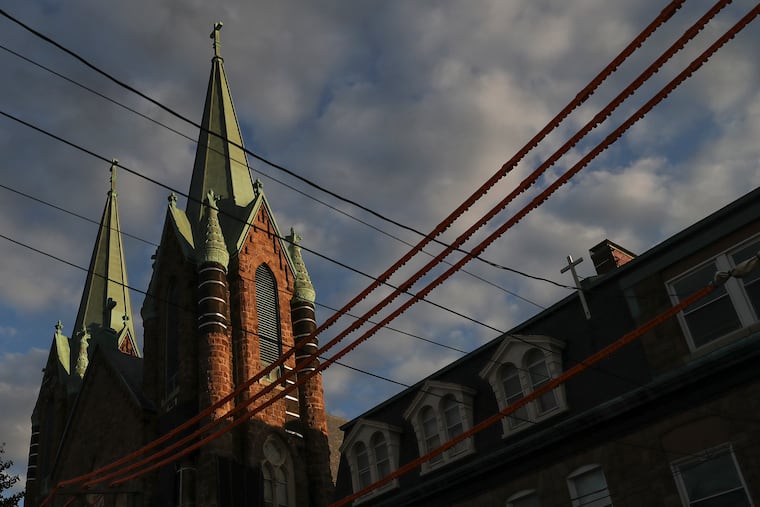The demolition of St. Laurentius could start this week with the dismantling of its skyline-defining spires
The scheduled demolition is the culmination of years of efforts by a developer to tear down the church and by neighbors to save it.

The teardown of the soaring twin church spires that define Fishtown’s skyline could start as early as Wednesday, the culmination of years of efforts to both preserve and demolish St. Laurentius, the neighborhood landmark and 19th-century former church.
Nearly a year ago, Philadelphia’s Department of Licenses and Inspections issued a demolition permit for the brownstone church at the corner of Berks and Memphis Streets, saying the building was unsafe. Now, the church’s owner, developer Humberto Fernandini of 1600 Berks LLC, is moving forward with plans to replace the church.
Why is St. Laurentius being demolished?
When L&I issued its demolition permit last September, the department said it had determined that the building was structurally unstable and in danger of collapsing and that it must come down. Its conclusion matched that of the owner’s engineers.
L&I had previously said that only the church’s deteriorating 150-foot towers should be demolished and that the rest of the building could and should be preserved. But L&I conceded last year that because the building is structurally compromised, removing the towers would lead to the collapse of the church, so the rest of the building would have to come down, too.
L&I cited a report by the owner’s engineers and other reports that documented the deterioration of the building. One analysis said that without action, the church would fall in a couple of years, according to L&I. Thousands of pounds of stones have fallen from the church in recent years.
Why is demolition starting now?
Before demolition work could begin, utility companies had to relocate poles and wires that ringed the property. That took longer than expected due to labor shortages and backlogged requests, according to L&I.
Complicating the demolition of the building is its next-door neighbor, St. Laurentius Catholic School, which teaches students from prekindergarten to eighth grade. L&I said in the spring that, for the children’s safety and because the academic year was almost over, it had directed the developer to wait until summer to start demolition of the towers, which loom above the school.
Workers have already removed nonstructural materials from inside the church.
Before exterior demolition can begin, the developer must complete preparations at the site and receive final approval from L&I. As of Monday afternoon, L&I had not given that approval. Work is tentatively scheduled to begin Wednesday.
What will the demolition look like?
Because the church sits next to a school in a dense neighborhood of rowhouses, workers will take down the church’s soaring spires by hand. The rest of the church also will be demolished almost entirely by hand. This means onlookers will see the building come down incrementally, not in a sudden cloud of dust.
The riskiest and most difficult element of the demolition is the removal of the church’s tall spires. They will take two to four weeks to come down. The rest of the demolition will take a few additional weeks.
L&I plans to inspect the property daily during demolition. According to the conditions of the demolition permit, a third-party special inspector also must be on site.
The Philadelphia Historical Commission has told the developer he must preserve or rebuild the church’s front face in any new development, and the developer plans to preserve it. St. Laurentius is on the Philadelphia Register of Historic Places.
How did St. Laurentius get to this point?
St. Laurentius Church was a Roman Catholic church built in the 1880s using donations from Polish immigrants. It has been a landmark for generations of Philadelphia residents.
Neighbors fought to get St. Laurentius a spot on the Philadelphia Register of Historic Places, which they did in July 2015 over the objections of the Archdiocese of Philadelphia. A local architectural historian said the church “represents the immigrant story” in the city and is a symbol of the architectural style of the era in which it was built.
» READ MORE: For now, St. Laurentius is safe from destruction (from 2015)
The archdiocese closed the church in 2014 after engineers said the building was unsafe. It has been deconsecrated.
Neighborhood residents and preservationists point to the building as an example of “demolition by neglect” — a practice in which a property is allowed to deteriorate to a point where the only option left is demolition.
A previous developer planned to convert the church into apartments, but a small group of residents sued to block the plan. Legal challenges drove away that developer.
The current developer, Fernandini, bought the church from the archdiocese for $50,000 in January 2020. He initially said he wanted to preserve the building and convert it into offices or apartments. The historical commission’s architectural committee noted that he did not try to shore up the church in the first months after the sale before asking that the city let him demolish it.
What will replace St. Laurentius?
Plans to redevelop the church site are still being worked out. The city issued a zoning permit in January for an eight-story multifamily residential building spanning more than 45,000 square feet with 49 residential units. But the permit was appealed.
The city’s Zoning Board of Adjustment approved the appeal, a decision the property owner now is challenging in Philadelphia’s Court of Common Pleas.